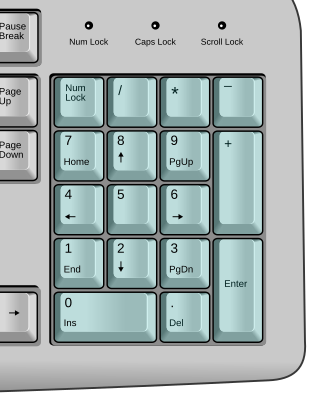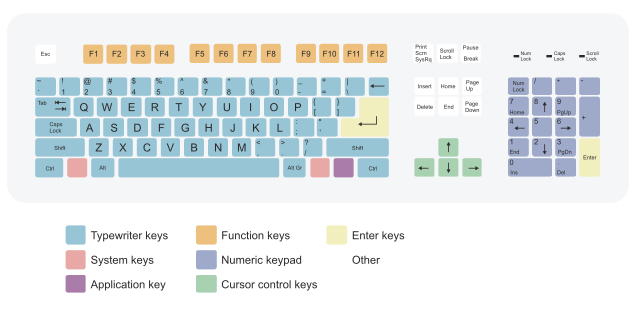Top Qs
Timeline
Chat
Perspective
Numeric keypad
Section of computer keyboard From Wikipedia, the free encyclopedia
Remove ads
A numeric keypad, number pad, numpad, or ten key,[1][2][3] is the calculator-style group of ten numeric keys accompanied by other keys, usually on the far right side of computer keyboard.[4] This grouping allows quick number entry with right hand, without the need to use both hands on number row of main keyboard.[4] On a standard IBM PC keyboard, numpad has 17 keys, including digits 0 to 9, + (addition), - (subtraction), * (multiplication), and / (division) symbols, . (decimal point), Num Lock, and ↵ Enter keys.[5] On smaller keyboards (such as those found on laptops[6]), the numeric keypad can be implemented as alternative markings on alphabetic keys (usually I-O-P, K-L-;, ,-.-/) or added as a separate unit,[4] that can be connected to a device by means such as USB; some of these may include keys not found on a standard numpad, such as a spacebar or a 00 (or 000) key.
This article needs additional citations for verification. (January 2008) |



Sometimes it is necessary to distinguish between a key on the numpad and an equivalent key elsewhere on the keyboard. For example, depending on the software in use,[a] pressing the numpad's 0 key may produce different results than pressing the alphanumeric 0 key.[b] In such cases, the numpad-specific key may be indicated as e.g. Numpad 0, NumPad0,[c] Num 0, or likewise to remove ambiguity.
Numeric keypads usually operate in two modes. When Num Lock is off, keys 8, 6, 2, and 4 act like arrow/navigation keys up, right, down, and left; and 7, 9, 3, and 1 act like Home, PgUp, PgDn, and End, respectively. With Num Lock on, digit keys produce the corresponding digit. On Apple Macintosh computers, which lack a Num Lock key, the numeric keypad always produces only numbers; the Num Lock key is replaced by the Clear key.
The arrangement of digits on numeric keypads with the 7-8-9 keys two rows above the 1-2-3 keys is derived from calculators and cash registers. It is notably different from the layout of telephone Touch-Tone keypads which have the 1-2-3 keys on top and 7-8-9 keys on the third row.
Numeric keypads are useful for entering long sequences of numbers quickly, such as in spreadsheets, financial/accounting programs, and calculators. Input in this style is similar to a calculator or adding machine.
A numeric keypad is also useful on Windows PCs for typing alt codes for special symbols; for example, the degree symbol, °, can be typed on these computers with the sequence Alt+0+1+7+6.[8]
To maintain their compact size, most laptops do not include a numeric keypad on their keyboard (though they can sometimes be found on larger models); even some desktop keyboards designed for compactness omit a numpad. To compensate, most such keyboards include Num Lock integrated into a function key (typically F6 or F8) and then press keys like 7 to produce their numpad counterpart.
Remove ads
Chinese input methods
The numeric keypad is used by some systems for input of Chinese characters, for example CKC Chinese Input System and Q9 input method.
Computer games and mousing alternative

Numeric keypads are also used for playing some older computer games where the player must control a character, such as roguelikes and Sid Meier's Pirates!. Unlike arrow keys, the numeric keypad can allow for diagonal movement. For keyboards without a numeric keypad, some games provide alternative movement keys, such as classic Rogue's HJKL keys.
The numeric keypad can also be an alternative to the WASD keys for navigation in computer gaming. This can be an attractive option for left-handed people who prefer to use the mouse with their left hand.
Most operating systems have a mouse keys accessibility feature where mouse navigation can be done using the numeric keypad, with the other keys adapted to be mouse buttons.
Remove ads
See also
Notes
- E.g. Blender makes specific use of numpad keys for several keyboard shortcuts.
- I.e. the 0 key above the letter keys and to the right of the 9 key on a typical QWERTY keyboard.
- E.g. as defined in C#'s
System.ConsoleKeyenumeration:[7]NumPad0 = 0x60, NumPad1 = 0x61, NumPad2 = 0x62, NumPad3 = 0x63, ...
References
Wikiwand - on
Seamless Wikipedia browsing. On steroids.
Remove ads
